Privacy Policy: We hate spam. You’ll receive a confirmation email first that your email address is correct before your resource is sent to you. Thanks!


Hello and welcome to Writing On Medium: The Ultimate Guide! If writing on Medium is something you want to pursue or improve, you’re in the right place.
>>> Are you looking for a platform that can get your passion and expertise in front of new readers every single day?
>>> Do you want to create written content that actually gets seen?
>>> Does the idea of getting paid to grow your email list pique your interest?
If you answered “yes” to any of those questions, writing on Medium is a great fit for you.
In this comprehensive 7,700-word guide, I’m taking you through everything I did in my first year of writing on Medium to get great results – and how you can do the same. LET’S DO THIS.
To make navigation of this guide simpler, I’ve divided Writing On Medium: The Ultimate Guide into chapters, and you can leapfrog to any chapter by clicking its link below.
A LASER-FOCUSED, GLUTEN-FREE TABLE OF CONTENTS
Introduction – Year One On Medium: A Quick Results Overview
Chapter 1 – What is Medium And Why Should I Write There?
Chapter 2 – Blogging On Medium: Why Write On Medium Instead Of A Blog?
Chapter 3 – Medium Publications: How To Write On Medium And Get Your Writing Seen
Chapter 4 – How To Get Followers On Medium (And Off Of Medium)
Chapter 5 – How To Make Money On Medium: Two Successful Approaches
Chapter 6 – Medium Stats: How To Measure Your Efforts And Progress
I began writing on Medium because I was tired of using other social media platforms to try and promote blog-esque content.
>> Facebook felt like a dumpster fire with flat-earthers on every corner (Qan0n… more like QaNOPE)
>>> LinkedIn has an articles feature, but I can count on one hand the number of views my articles were actually getting
>>> And while I love Instagram, writing stands no chance against a perfectly-timed meme.
These social media platforms seemed crowded, crazy, and/or difficult to crack. This was not the case with Medium.
In my first year on Medium, I attracted over 220,000 views on my articles. Here are the twelve screenshots showing each month’s performance in 2020.
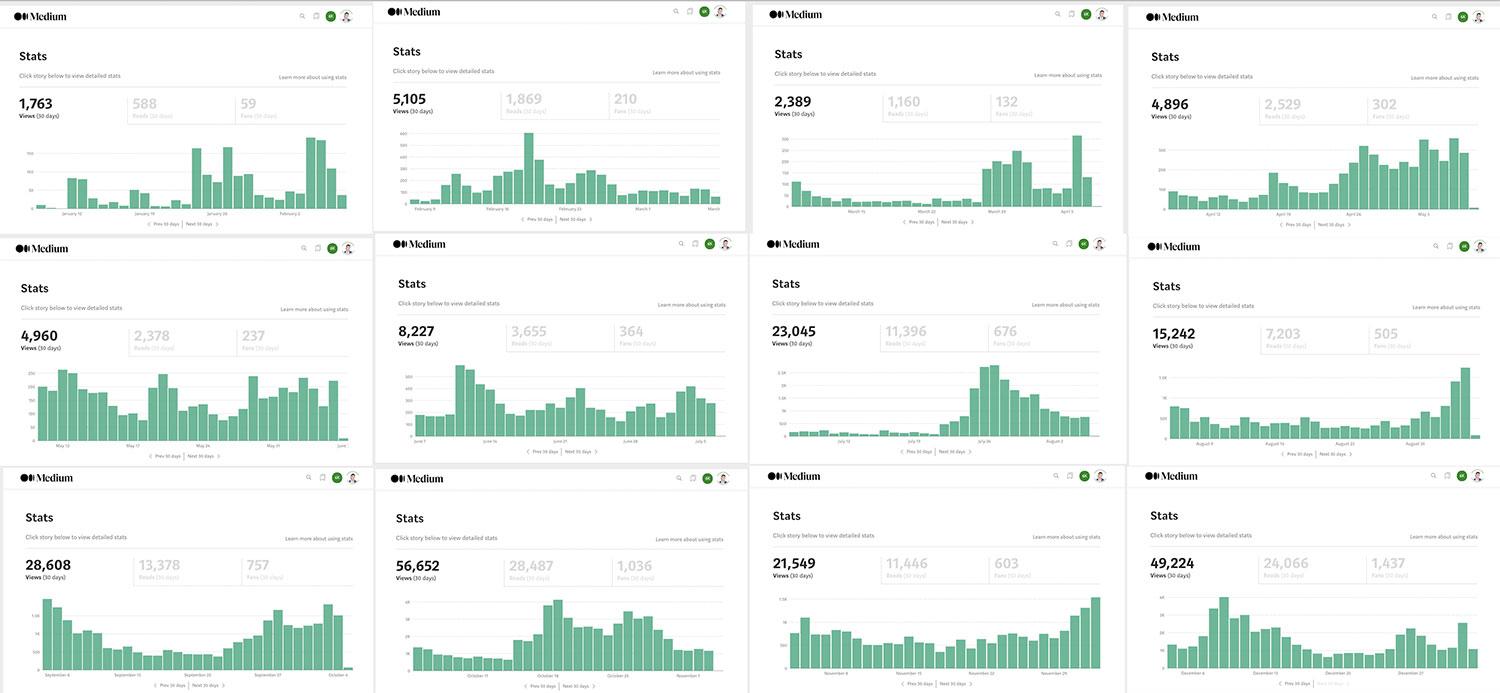
I also brought in a net gain of over 3,600 new email subscribers to my list by offering a freebie at the end of my articles and having the right strategy while writing on Medium.

When readers subscribe, I offer them a limited-time discount for one of my mini-courses. This is all automated.
You don’t have to do this, but if you have any products, programs, or services, this setup can be an easy way to add some income to the picture.
I put a limited-time offer in place about halfway through the year, and another limited-time offer in place near the end of the year.
Together, these made $10,714, and once they were all set up I didn’t lift a finger.
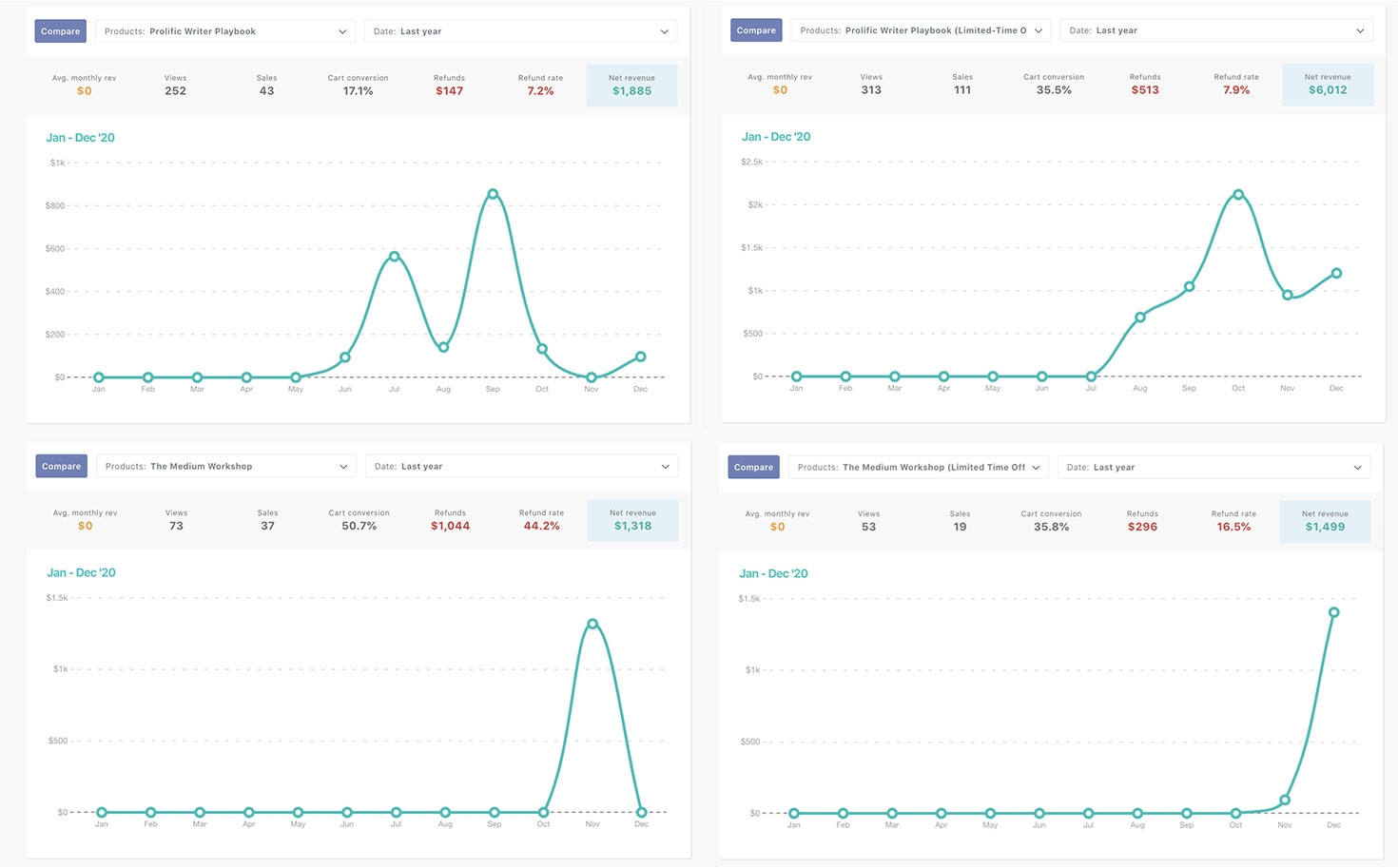
But my favorite detail is that when you put your articles behind a paywall on Medium, you are paid based on member reading time from Medium’s $5/month paying subscribers.
(Don’t worry, you can share paywalled articles with your non-Medium audience for free using something called “friend links”, which we’ll get into in Chapter 5.)
You read that correctly: I get paid to grow my email list!
In 2020, Medium paid me $7,685.98 to grow my list.

Most of that money went back into my business, but I did also splurge and buy us a Nintendo Switch to make pandemic living a little more tolerable.
If you like to write, Medium is a great option.
Here’s the kicker: I actually didn’t make much progress in those first three months because I was making critical mistakes.
For example, in the email subscribers screenshot above, the report is from April 1st to December 31st…
That’s because for the first three months of the year I was publishing my articles with outlets that don’t allow a lick of self-promotion.
I thought it was fine at the time… I told myself I was “Being visible” (Whatever the f*** that means)
But my email list subscriber growth in those first three months was… zero.
I likely left thousands of dollars and subscribers on the table in this first year as a result.
I don’t want you to make the same mistakes I have made. That’s what this guide is for.
People like to hate on Medium, but that’s because they don’t know how to leverage writing on Medium correctly.
Most people think of Medium only as a blog where they self-publish their writing in lieu of a website.
It’s way more than that – and most entrepreneurs aren’t seeing it because the really good stuff flies under the radar.
There are some underground strategies you can be using to get better results – even if you’re starting from zero:
>>> You can use curation to ensure your articles get distributed over and over again on Medium’s platform and in Medium’s daily emails to subscribers.
>>> You can submit to user-owned publications that have large followings and will let you publish your work with them. Some of them will also let you include a self-promotional link (This is what I do, personally).
>>> Comments on content don’t drive article distribution. THANK F***-ING GOD. This means the quality and value of your writing determines how well you get distributed, not a popularity contest.
It’s a nice break from social media algorithms for sure!
Since Medium’s design is very clean, you don’t have to compete with super fancy brands, video creators, or selfie-slinging influencers.
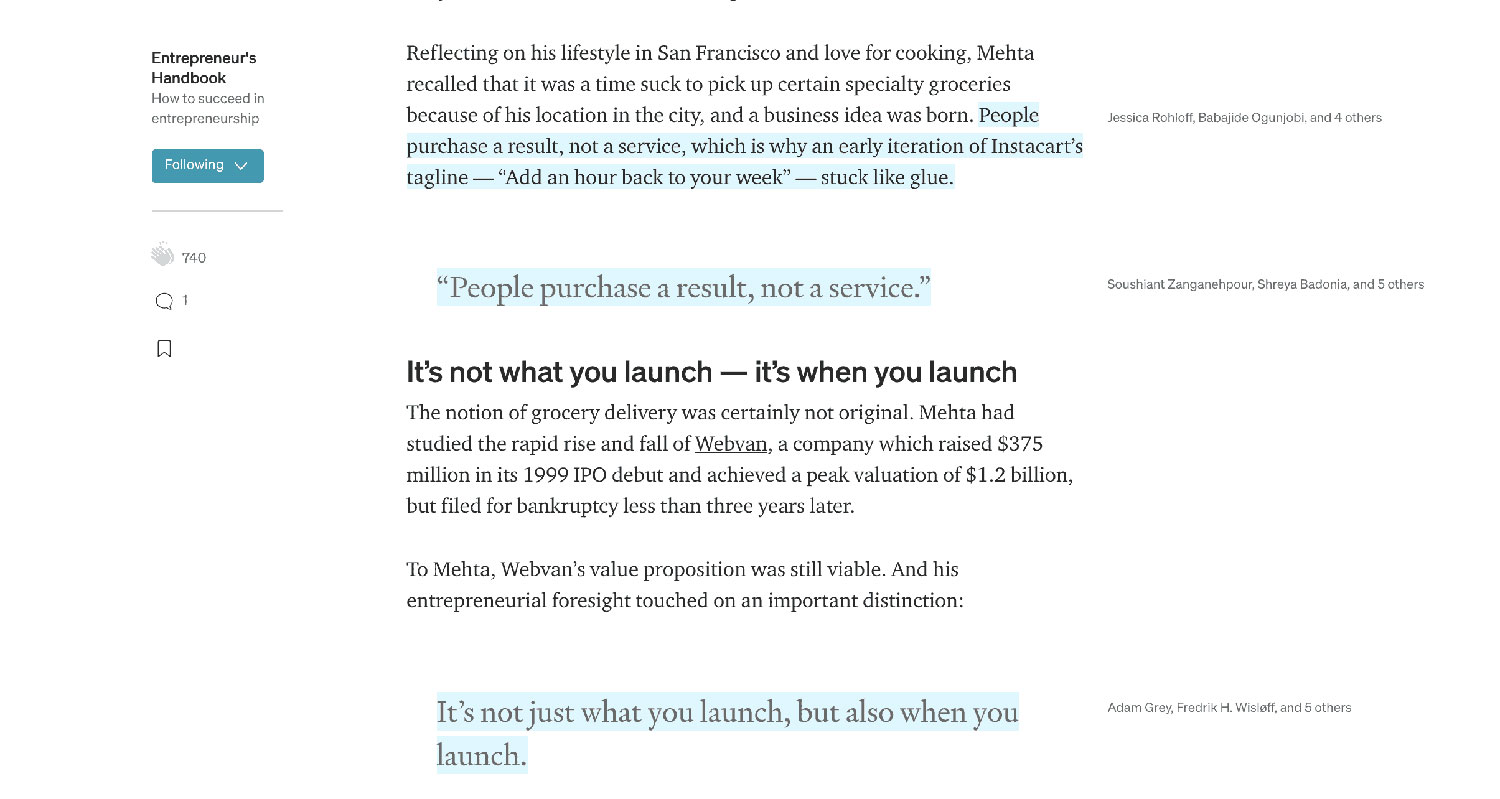
The biggest value Medium provides, in my opinion, is a way to grow your email list organically with happy, engaged subscribers.
This could be a great option if you are:
>>> A busy professional who can’t drop everything to reply to someone’s comment
>>> An online entrepreneur looking to draw in readers and build a following of quality, engaged subscribers
>>> An upstart youngster ready to make a few extra bucks a month (or hundred or thousand) by writing articles and placing them on an algorithm-driven website.
We’re about to dive in – but before we do, I have one last announcement.
To help you cement what you learn today and start taking action, I have a snack pack of resources that are free for you to download.
Written freebies, audio freebies, a video freebie, oh my! All designed to help you wrap your head around Medium as a potential outlet for your expertise.
It’s called the Medium Jumpstart Toolkit, and this box below tells you what all is in it!

To supplement this guide and help you take action, I have a free toolkit you should check out. It’s called The Medium Jumpstart Toolkit, and it includes:
– “The 5-Step Checklist For Succeeding On Medium” PDF
– A free, private 5-episode mini-podcast
– A behind-the-scenes video of exactly how I run my Medium workflow using Google Docs and Google Sheets

Medium was founded in 2012 by former Twitter founder Ev Williams as a way for people to share updates and ideas that were longer than 140 characters.
One reason professionals are confused about writing on Medium is that it’s changed a lot over the last few years.
>>> From 2012-2015, the site operated mainly like a digital magazine.
>>> Then in 2017, Medium introduced an optional membership paywall and began distributing its paywall earnings to writers who can prove they create quality content.
>>> The last audience size number given publicly by Medium was 60 million readers in 2016. It’s estimated today that Medium has over 100 million readers.
In recent years, Medium has also become the vehicle of choice by various celebrities, politicians, and big thinkers to tell their stories or make official statements.
For example, here’s a Medium blog from U.S. Vice President Kamala Harris sharing about some recent remarks on the economy:

And here was a piece from influencer Chrissy Teigen sharing about a grief-stricken personal experience in a format longer than a series of Tweets or an Instagram caption.
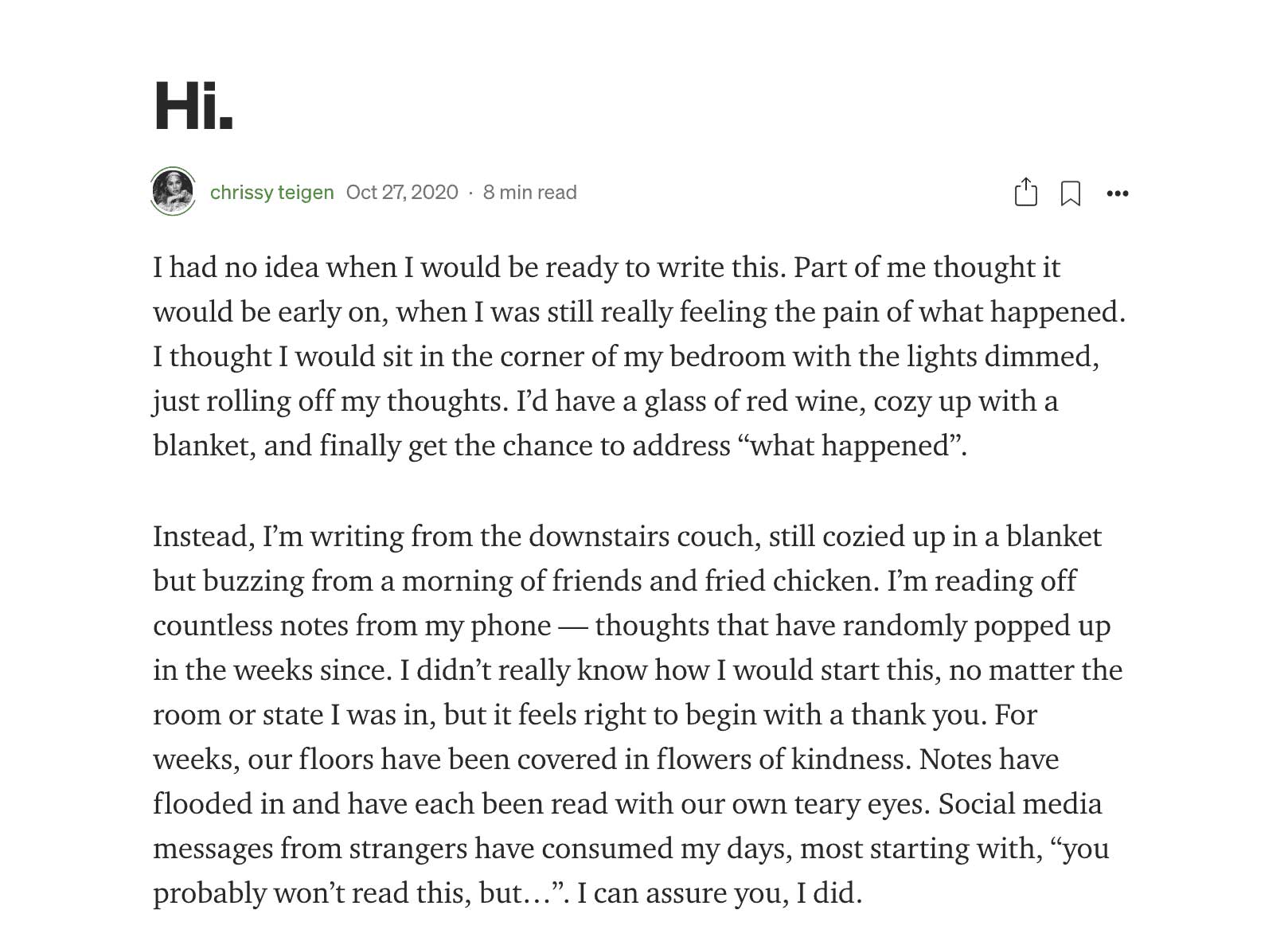
There are also successful authors who use Medium regularly.
Laura Vanderkam, author of several bestselling books and a contributor for places like Fortune and The Wall Street Journal, is writing on Medium.
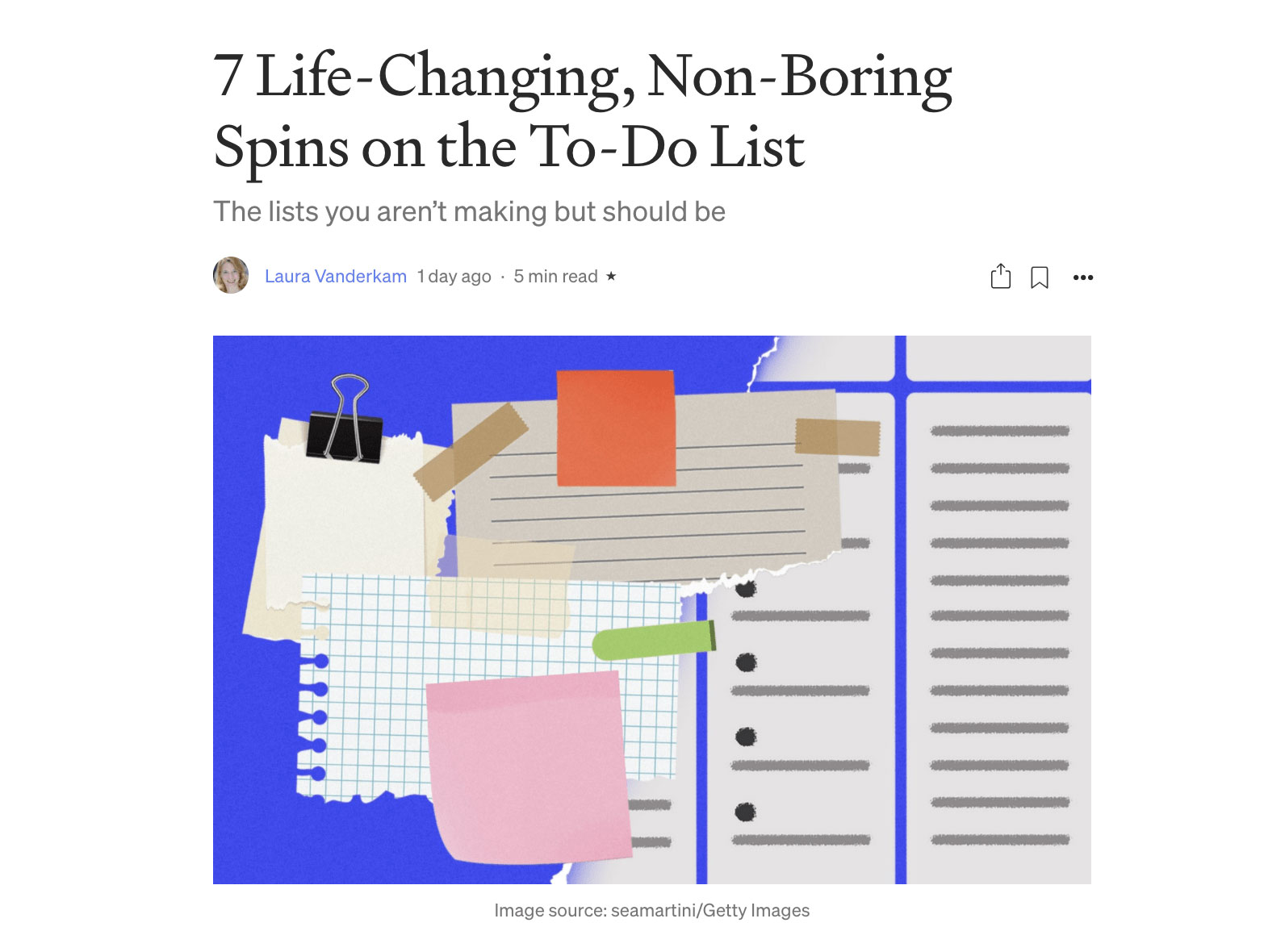
Susan Orlean, an award-winning author who was portrayed by Meryl Streep in the 2003 film Adaptation, is also writing on Medium.
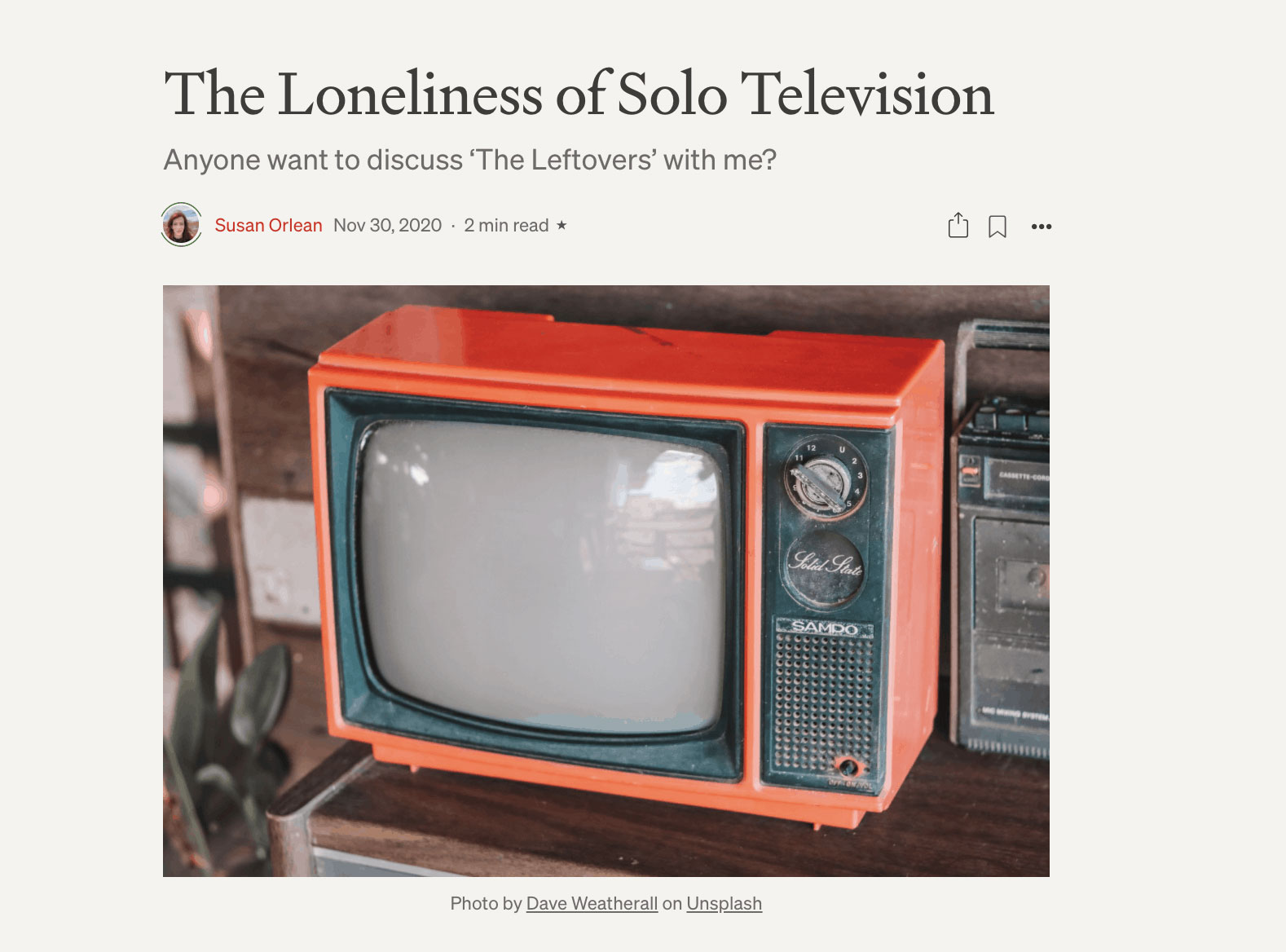
Medium wants to attract top talent, and that talent includes editors from the media world for some of their company-owned publications. (We’ll get more into publications in chapter 3.)
For example, at Elemental, a Medium publication about health, the editors previously worked at places like Time Magazine.

At Forge, a publication about productivity and working life, editors previously worked at places like Lifehacker and Quartz and have written for places like The New York Times.

Not all the publications on Medium are run by Medium themselves – and that’s where opportunity lies, which we’ll get to in a moment.
For now, know that professionals take writing on Medium seriously and see its potential as a platform.
The SEO company Moz created a metric called domain authority to help users measure the likelihood that a search engine like Google or Bing will rank a certain page of a website.
This score is not the only factor in ranking search engine results, but it does help to measure the “health” of a website.
If you choose to write on Medium instead of, say, your own blog, you’ll be able to “piggyback” on Medium’s high domain score.
For example, here is the domain authority of my website, a piddly 30 out of 100 at the time of this writing:
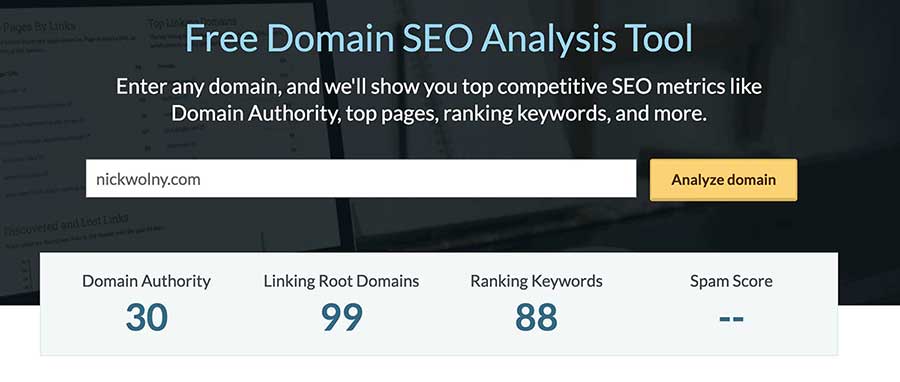
Here is the same domain authority score for medium.com.
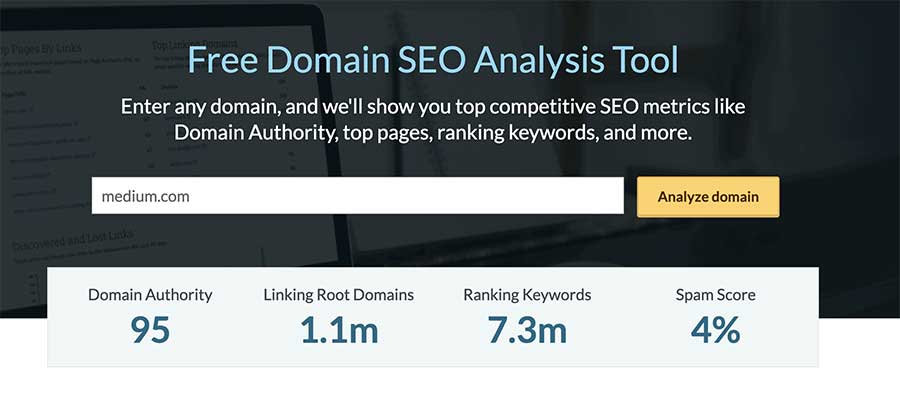
Yowza! So in terms of visibility from SEO, my work has a better shot of being seen by new eyeballs when I publish it on Medium since my blog hasn’t been around since the stone age.
(Also – Medium does not curate content about Medium itself. Otherwise this blog would probably have been published on Medium instead.)
For example, here’s an article I wrote some time ago: How I Got Published In Business Insider In 36 Hours Flat.
For the search query “How to write for Business Insider”, I am now the #2 search result, behind Business Insider themselves.
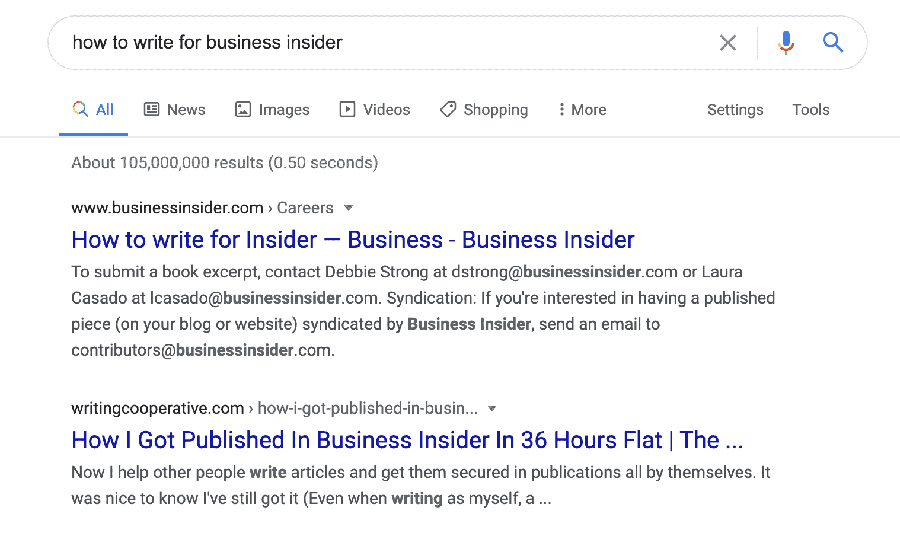
That’s a pretty good placement for an article that’s less than a year old!
I would have never been able to achieve that if I had published the same piece on my own blog because my website’s domain authority is too low.
Medium, on the other hand, has an enormous domain authority.
Usually, writing for websites with this high domain authority is a challenge. For example, I write for Entrepreneur and Fast Company, and to write for these sites I have to pitch every article.
A lot of pitches get turned down, and if a pitch is accepted it can be two to six weeks before my completed article gets published.
With Medium, you don’t have that problem. And in many Medium articles, you can promote a freebie, personal newsletter, or your own website in the article’s signoff. (**whispers loudly** That’s what you should do too.)
Writing on Medium is a great opportunity for entrepreneurs. =
CHAPTER 1: A CUTE LIL’ SUMMARY
>>> Writing on Medium has had many formats since inception, and the company has hit its stride in the last few years.
>>> Medium has the buy-in of industry professionals.
>>> Medium presents a way for you to “piggyback” on the site’s high domain authority and get your writing seen by more people.

To supplement this guide and help you take action, I have a free toolkit you should check out. It’s called The Medium Jumpstart Toolkit, and it includes:
– “The 5-Step Checklist For Succeeding On Medium” PDF
– A free, private 5-episode mini-podcast
– A behind-the-scenes video of exactly how I run my Medium workflow using Google Docs and Google Sheets

In the previous chapter, we talked about how domain authority is one of the best reasons to write on Medium instead of on your blog.
But what if you don’t have a blog, or don’t care about having one? Should you still explore writing on Medium?
The answer is yes, yes, yesssss. (Dare I say… Yasssss.)
Writing on Medium has several advantages with regard to visibility, design, and ease of use; let’s go through a few of them now.
Advantage #1: Medium will “curate” your articles
When you put a piece of content on Medium, it gets read by people at Medium called curators. That’s right, actual humans read every single article posted on Medium!
Curators will check that your article follows Medium’s guidelines (The guidelines are straightforward: “Correct spelling and punctuation”, “no hate speech”, et cetera).
If they feel that the article is of a certain level of quality, they will choose your article for further distribution and curate your article on various curation tags.
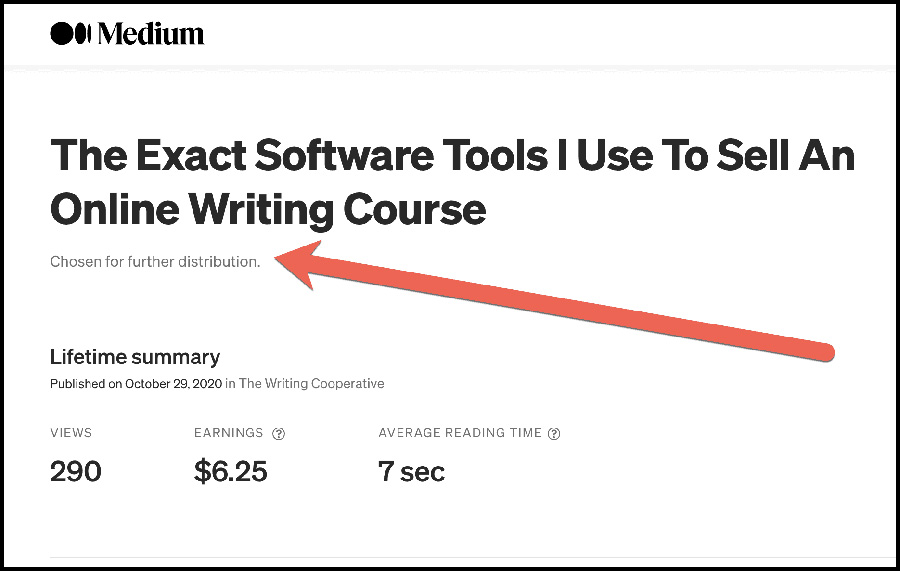
Tags are topics on Medium that readers can choose to follow.
You can also tag your own articles with up to 5 tags, but it’s the blessing of a curator who determines whether or not your article will be actively distributed to followers of that tag.
I can’t overemphasize enough how valuable this is.
As someone who has spent years in marketing consulting agonizing over how to ensure good content gets seen again and again for years to come, having a way for content you’ve published to be actively pushed to readers over and over again is f***-ing amazing.
Medium readers will see your curated articles in two places: Their dashboard and in daily digest emails.
The Medium dashboard recommends articles to readers every day. Think of it like a YouTube dashboard; the recommendations are based on a mix of your reading history and the tags, publications, or authors that you follow.
Your curated article may also be placed in a daily or weekly digest email that goes out to readers.
That’s right: Your article will literally land in the inboxes of readers even if they’re not on your email list.
In some circumstances, your article title and your name will actually be the headline of the email itself, which is great for visibility. Here’s a screenshot from my inbox.
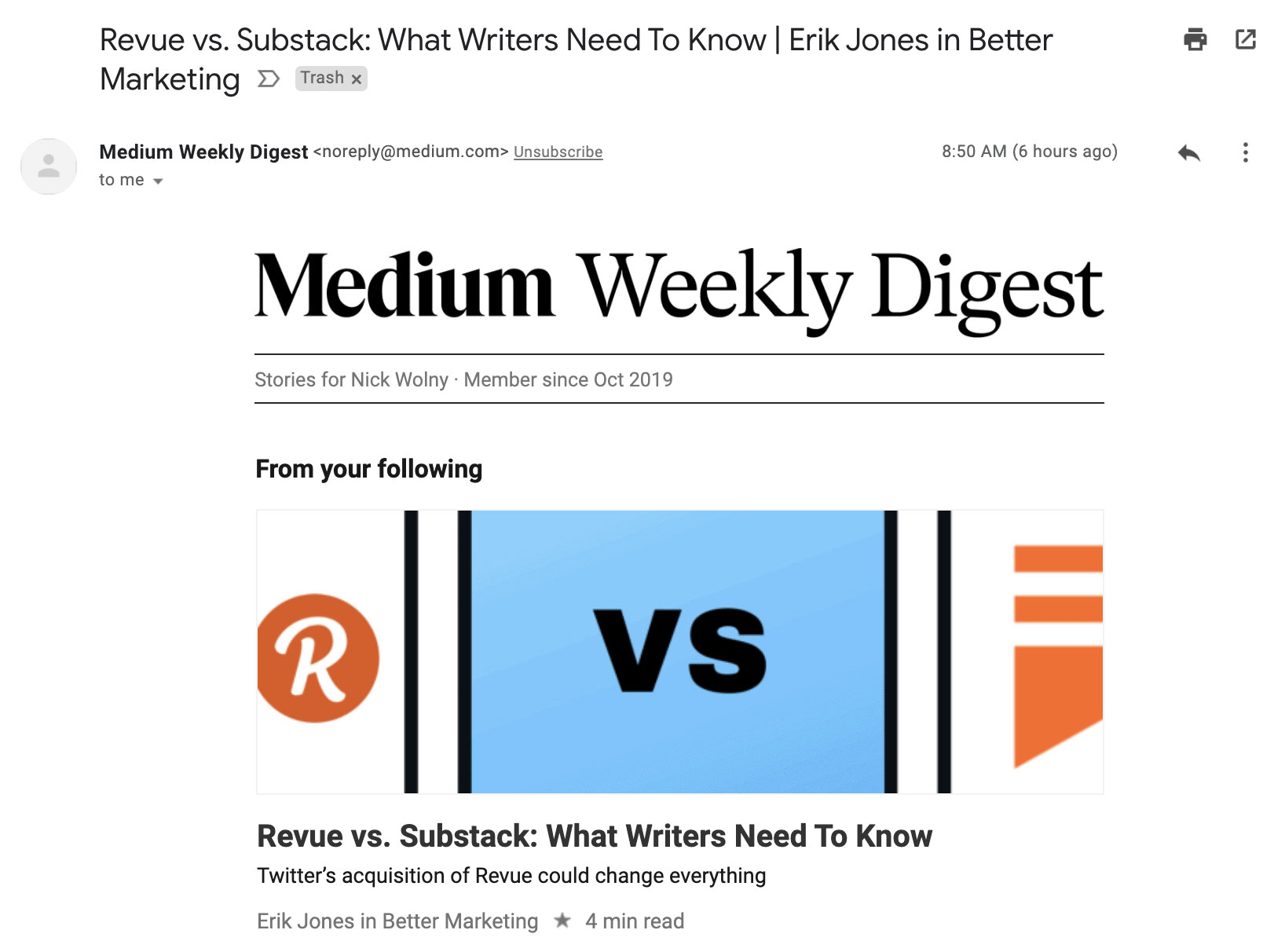
Right now, writing on Medium feels similar to how blogging and SEO were in 2010, when things weren’t so saturated and competitive.
Now, SEO is much more of a long game.
Medium is not a long game and you can start getting results now.
Advantage #2: Medium gives you valuable user feedback
As content creators and entrepreneurs, we know it’s virtually impossible to get everything right on the very first try. That’s why you need feedback loops.
You want to know
— How many views your articles are getting,
— How long your readers are staying on the page, and
— Which topics or article styles work – and which ones don’t.
Writing on Medium gives you this feedback. These stats are similar to what you’d see in a Google Analytics dashboard, but since Medium has its own ecosystem of traffic, you can start getting feedback way sooner.
You can also see how much money an article has made if you are placing your articles behind the paywall.
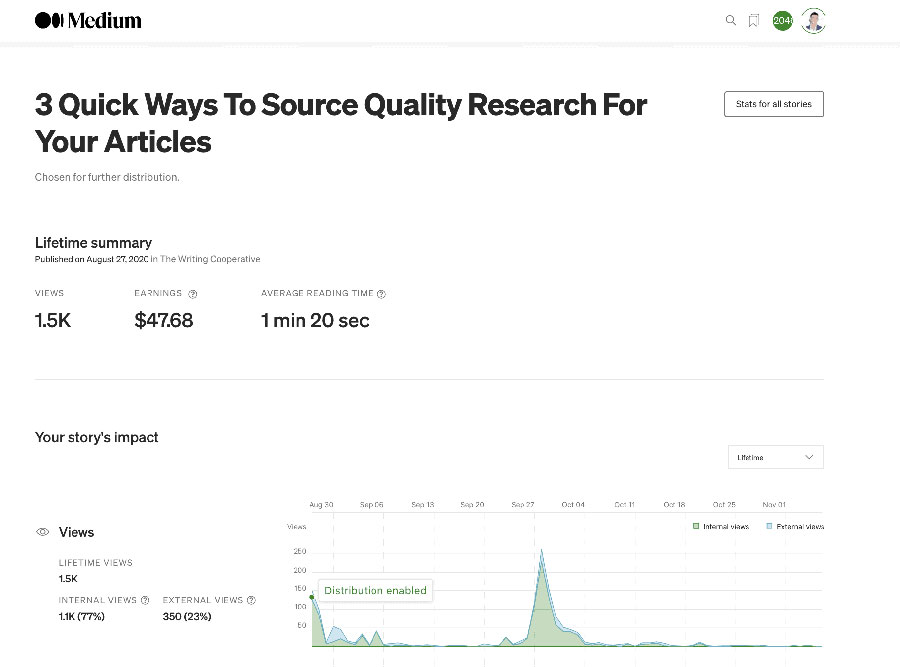

Overall, I like that the Medium stats dashboard gives you all of the information you need to make decisions and none of the stuff that can easily snowball into information overwhelm.
Advantage #3: Medium readers actually like to read!
This is a more subjective note, but I think it’s important to keep in mind: Medium’s readers actually want to read content.
It can sometimes feel like the internet is overwhelmed with videos, sassy GIFs, crazy-fast memes, and other “fast” content.
Medium’s design is simple, and articles that attempt to embed super-flashy videos or multimedia often don’t do well.
Readers are here to read words, so if you don’t have any branded design or anything like that, you don’t need it to get started.
Since my main tool for connecting with people is my email list, I want to attract people who like to read.
Medium has this exact audience built directly into the platform.
If you sign up for the Medium Partner Program (Explained more in chapter 5) and put your articles behind the paywall, your audience of readers becomes mainly readers who are paying to read on the platform, which means the audience quality is even higher.
These readers are paying to read articles just like yours, and you’ll receive a cut of their membership dues as a result.
Signing up for the MPP is optional, but you’ll access a more invested audience by doing so. Audience quality matters.
CHAPTER 2: A TL;DR SUMMARY
>>> Medium’s curation tags are one of the most powerful ways to get longevity out of your articles.
>>> Medium gives you feedback loops and data so you can figure out what works and what doesn’t.
>>> Medium subscribers actually like to read and value a platform that is word-centric, rather than flashing lights and live streams everywhere.

To supplement this guide and help you take action, I have a free toolkit you should check out. It’s called The Medium Jumpstart Toolkit, and it includes:
– “The 5-Step Checklist For Succeeding On Medium” PDF
– A free, private 5-episode mini-podcast
– A behind-the-scenes video of exactly how I run my Medium workflow using Google Docs and Google Sheets

When writing on Medium, you can choose to either self-publish your article or submit your article to a publication for consideration.
Publications are an exciting concept within Medium and are fairly new.
In a way, they are like miniature media outlets, catering to audiences within Medium’s overall ecosystem.
Users on Medium can choose to follow different publications, and when they do so, new articles published in that publication will be put in front of them.
This is a great way to get in front of your ideal readers and people who want to read about the subject matter that you are passionate about.
There are all types of publications!
For example, one publication I like writing for, Entrepreneur’s Handbook, has over 190,000 followers.
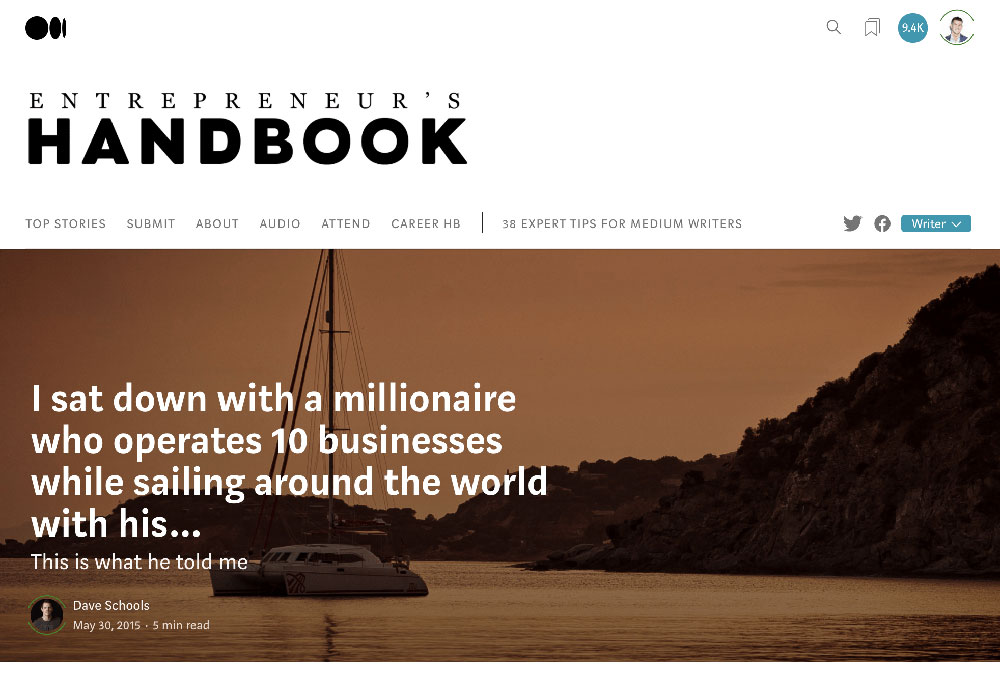
Here’s a rapidly growing publication on mental health called Invisible Illness that publishes a mix of science-backed articles and personal essays.

Mind Café, a personal development publication, has over 100,000 followers. The publication actually launched a quarterly physical magazine product last year as well.
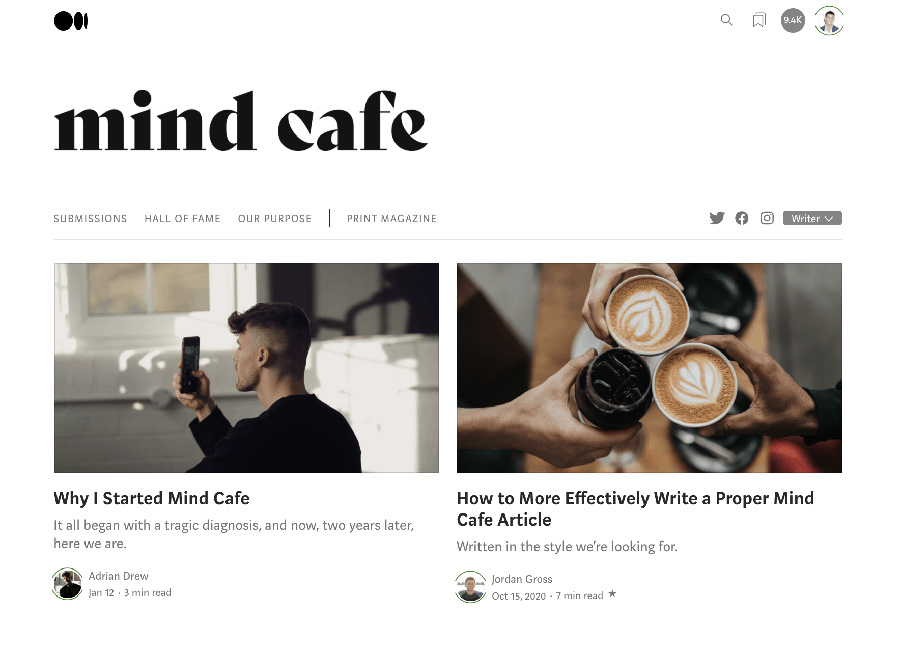
Generally, there are two types of publications.
Publication type #1: Publications owned by Medium
Medium’s team operates these publications and poached top editors from the media industry to run them. Freelance journalists, experts, and storytellers alike write for Medium’s publications.
They are competitive, but you are paid an upfront stipend when you write for them, then also paid through the Medium Partner Program based on performance.
A few popular Medium owned publications include:
>>> Forge, a publication focused on productivity and personal development,
>>> Future Human, a publication dedicated to cool new science,
>>> Human Parts, nuanced stories about the human experience, and
>>> Modus, a publication dedicated to all things design.
Articles published with Medium-owned publications are sometimes distributed to all of Medium’s readers, making them a terrific opportunity to attract readers and followers to your work.
You cannot have a personal call-to-action or any self-promotion in articles written for Medium publications, but they are excellent for visibility and street cred.
And think about it – if people like your work and start to follow you, down the line they’ll see other articles of yours that do have a call-to-action.
My recommendation is to pitch these publications after you have some articles in user-owned publications first so you don’t waste the potential.
Publication type #2: User-owned publications
These publications are created by members of Medium themselves, and you could start a publication tomorrow if you wanted.
Some writers actually create a publication, then make themselves the only contributor, which allows them to use the publication as their own blog.
In user-owned publications, the writer submits a completed article draft to the publication’s editors, the editors consider the article, and then your article is either published or rejected with some revision requests or a hard pass.
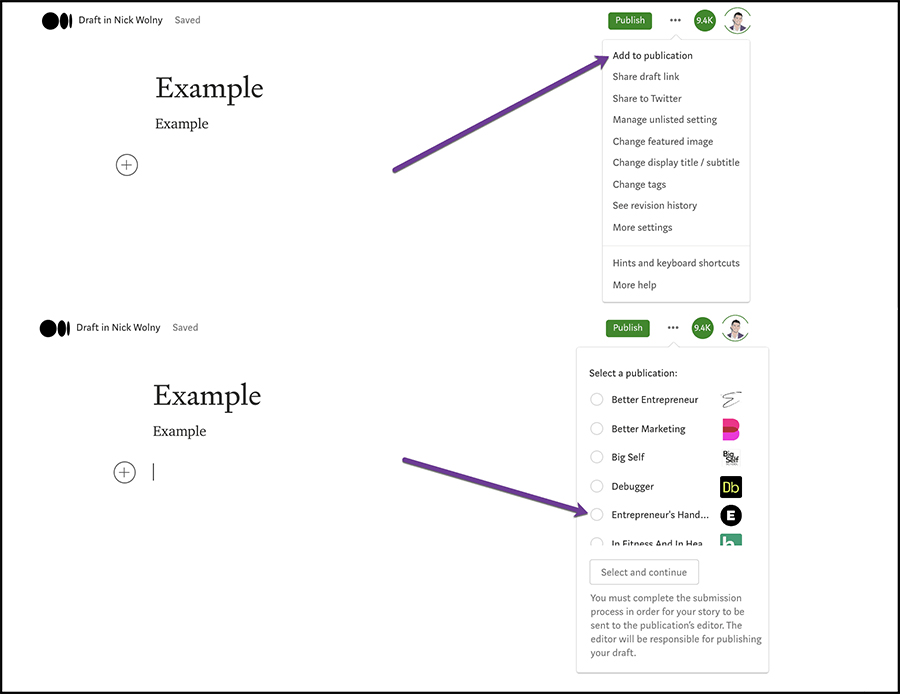
This brings up an important distinction: You have to write the article first, then upload it in order to pitch it.
This means that, to be successful on Medium, you need to get comfortable with writing regularly, and that process can take time and skill. Develop the skill of writing articles quickly and regularly!
(Quick personal plug: I have a mini-course called the Prolific Writer Playbook on how to write articles quickly and consistently. If that interests you, more info is available here.)
User-owned publications are a really exciting opportunity for three reasons:
Exciting opportunity #1: User-owned publications are pretty new
User-owned publications only began in 2017, so there isn’t a ton of competition at the moment.
Publications become increasingly saturated as time goes on, which is why it’s good to get in now.
New publications are being created all the time, and Medium’s readership is also rising all the time, so there are always fresh opportunities.
Exciting opportunity #2: User-owned publications are easier to get into
It can be easier to find your footing in user-owned publications and get your work accepted than the Medium-owned ones.
Even with having bylines in fancy outlets like Entrepreneur and Fast Company, it still took me almost a year to get a piece accepted by a Medium-owned publication.
However, I was building my readership and audience throughout the year by prioritizing user-owned publications.
Exciting opportunity #3: User-owned publications will let you self-promote (usually)
Medium’s guidelines state that overly self-promotional articles will not be curated, but what you can include is a link and a short call-to-action of up to 40 words in your articles.
As we’ll discuss more in chapter 4, this is a key and often-overlooked detail that makes all the difference. Here is my call-to-action (CTA):

There are writers on Medium who have tens of thousands of followers and don’t have to worry about curation or publications as much.
If you’re just getting started like I was, you don’t have that luxury.
Curation and publications are the fastest way to grow your audience on Medium, and a good article can leverage both audience. I still mainly use this approach.
CHAPTER 3: SUMMARY (WITH A SIDE OF BACON, PLEASE)
>>> Medium has its own little ecosystem of publications.
>>> Publications are a new feature (Created in 2017) with not too much competition… yet. They’re a great visibility opportunity.
>>> Medium has its own publications, run by top editors, that are great for credibility and visibility.
There are also user-owned publications; these are niche, and many of them let you have a self-promotional link, which is very valuable.

To supplement this guide and help you take action, I have a free toolkit you should check out. It’s called The Medium Jumpstart Toolkit, and it includes:
– “The 5-Step Checklist For Succeeding On Medium” PDF
– A free, private 5-episode mini-podcast
– A behind-the-scenes video of exactly how I run my Medium workflow using Google Docs and Google Sheets

Oh boy, here we go! Get excited – this is one of the most impactful chapters of this entire guide.
As someone who has been a consultant for years, I can say one of my biggest regrets is that I wasn’t building an audience along the way.
Your audience can be your sounding board for new ideas, and often when you announce a new product, program, or service they are the first to sign up because they are the people who know you best.
My professional recommendation is that you work to bring your audience off of Medium and onto an email list.
That being said, having followers on Medium does help. So let’s go through both approaches now.
#1: Growing an audience off of Medium
Building an email list is incredibly valuable.
According to VentureBeat, the ROI on email marketing is 40:1, which outperforms the ROI of social media, ads, sponsorships, and direct mail.
The reason email does so well is that it lets you get in front of your audience for free: There are no ads and no algorithms in your way.
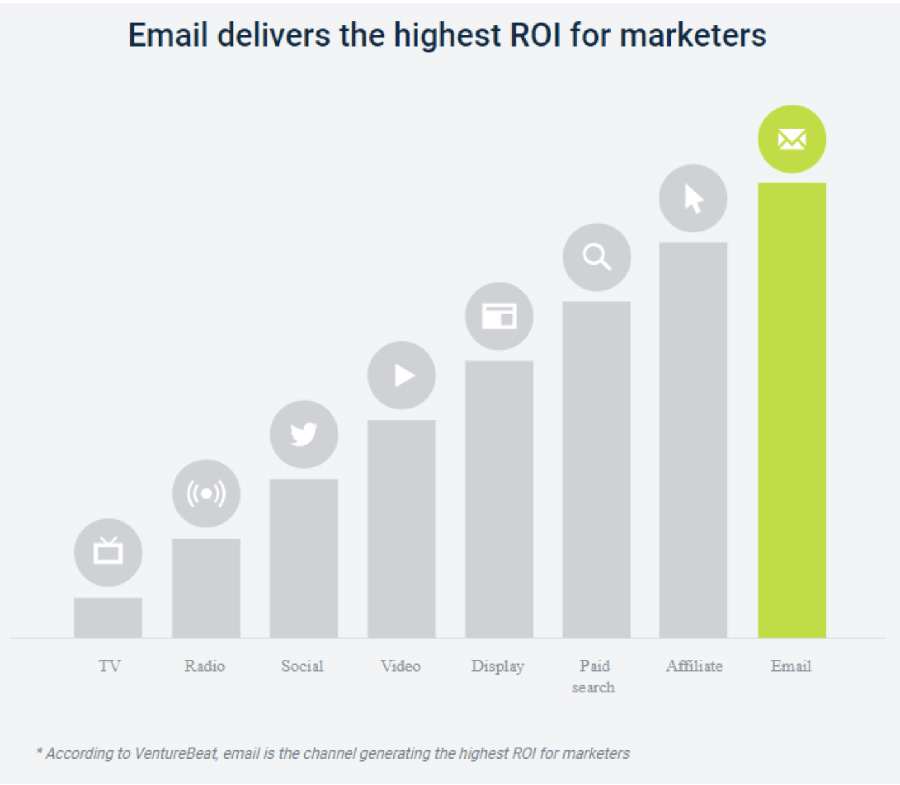
I’ve been in digital marketing for years, and lemme tell ya: Promotional platforms come and go.
I’ve seen platforms in which people grow their audience on a platform, only to have the platform make it increasingly difficult to reach your audience.
Just a few years ago, Facebook Business pages were red-hot. Posts on Facebook Business pages used to reach 100% of the page’s followers.
Then, over the years, Facebook became more saturated and more focused on profitability.
Algorithm tweaks ensued and posts began to go in front of progressively fewer followers (Unless you paid to boost them).
Nowadays, it’s normal for posts from a page to reach fewer than 5% of their followers.
You work hard to grow your audience. I want to ensure that an algorithm switcheroo like that doesn’t happen to you.
Platforms will continue to come and go, but an email list remains one of the best ways to directly communicate with your audience.
So how do you have Medium readers come off of Medium and onto your email list?
Well, you could just ask them and have a call-to-action that says something along the lines of “Sign up for my newsletter.”
PSA: No one wants more emails. The “join my newsletter” plea is kind of a hard sell.
In fact, here’s some found footage of me opening my email inbox the other day:
People don’t want more emails – but they do want their problems solved.
So in digital marketing, it’s common to offer what is called a “lead magnet” or “ethical bribe” as a way to invite people onto your email list.
A lead magnet is a free piece of content you offer people in exchange for them joining your list.
You already encounter lead magnets all the time on the internet without even realizing it.
Anytime you are offered a discount or a free gift in exchange for your email address, you are being offered a lead magnet
For example, the gender-neutral apparel website TomboyX offers you free shipping on your first purchase in exchange for your email address. That discount is a lead magnet.
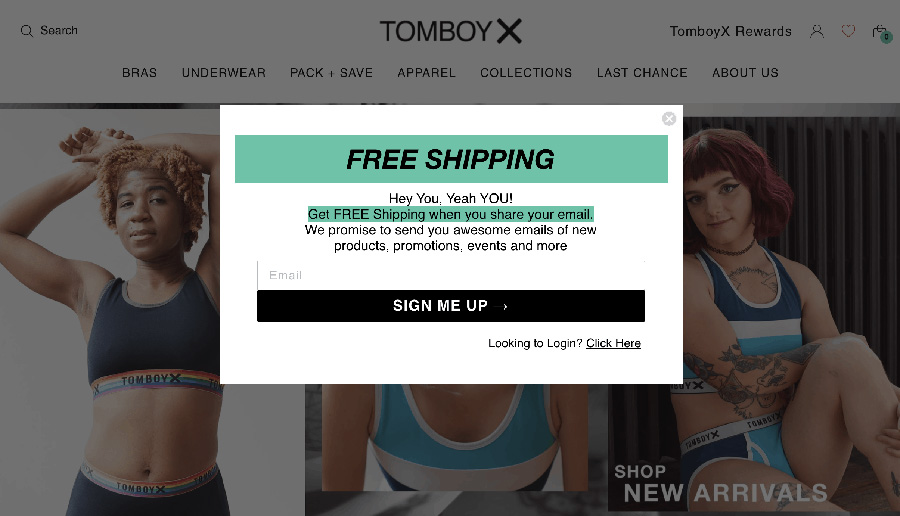
The media outlet Social Media Examiner has a report summarizing survey responses they’ve received from over 50,000 marketers. That piece of content is a lead magnet.
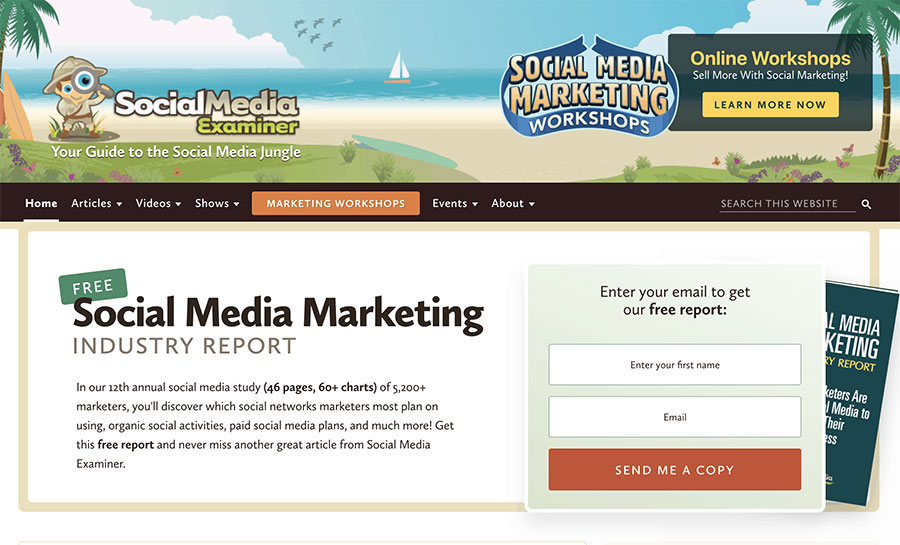
You get the idea. Lead magnets are a tried-and-true way to grow your email list.
#2: Growing an audience on Medium
Readers can follow you on Medium, and having followers can be a great way to get your articles seen.
We’ll talk about this more in chapter 6 – the chapter on metrics and analytics – but know that views on your articles and time spent actually reading an article are more important than follower count.
I have a small follower count compared to other writers, but our article traffic is about the same. Follower count does not always mean more traffic.
Like most other big platforms, there are some people trying to cut corners. Buying followers or buying “Claps” (Medium’s version of likes) is, unfortunately becoming increasingly common.
While that vanity metric looks good, it won’t contribute a whole lot to growth on the backend.
Having readers follow you can be a distribution tactic along with publications and curation tags.
The best advice I can give on follower growth is to write quality articles that make readers want to follow you in the future.
When readers come into your orbit on Medium, you don’t just develop an audience; you can also create a new stream of income.
How, you ask? Read on to the next chapter to find out the two approaches you can take.
CHAPTER 4: SUMMARY SUMMARY BO BUMMARY
>>> When you grow your following on Medium, your followers will see your future articles in their feeds or daily digests – this is great for visibility.
>>> Also, think about how you can leverage this visibility to grow an audience off of Medium that you can communicate with directly.
>>> The one asset I recommend you be building all the time is your email list.

To supplement this guide and help you take action, I have a free toolkit you should check out. It’s called The Medium Jumpstart Toolkit, and it includes:
– “The 5-Step Checklist For Succeeding On Medium” PDF
– A free, private 5-episode mini-podcast
– A behind-the-scenes video of exactly how I run my Medium workflow using Google Docs and Google Sheets

If you are looking to make money from writing on Medium, there are two ways to do it.
I do both, personally! And you can do both too as well if you like.
Let’s go through each of these strategies in a little more detail now.
Make Money On Medium Strategy #1: The Medium Partner Program
Medium is a great marketing and visibility tool. But there’s something else about Medium that is pretty neat, and that is the Medium Partner Program.
Medium will pay you for your content, and pay accordingly for how well your content performs!
The Medium Partner Program allows you to get paid based on read time for your articles.
There are some content creators who make so much money on Medium that it becomes a side hustle income or even their entire income.
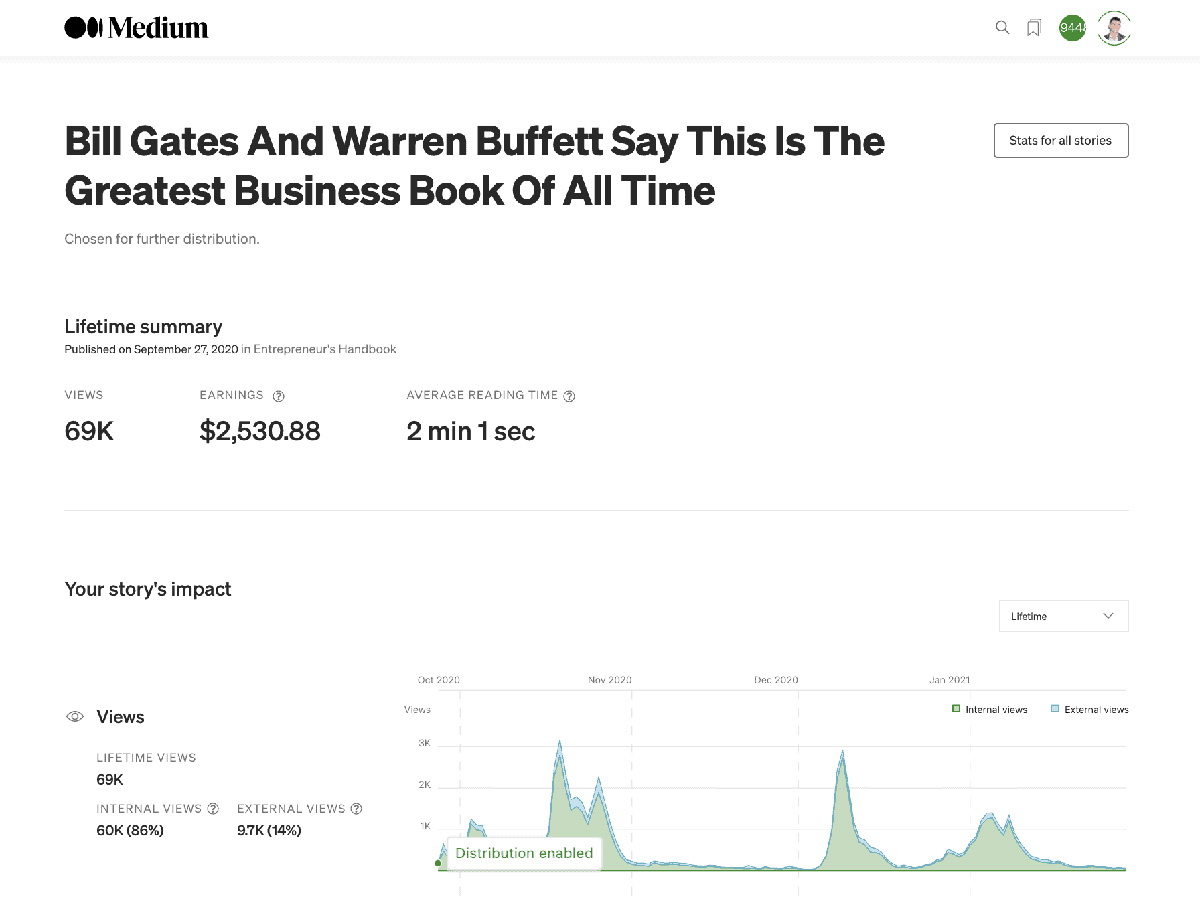
When you use the Medium Partner Program, articles that you place behind a paywall can monetize. You don’t have to put all your articles behind Medium’s paywall if you don’t want to.
You can also use something called “friend links” on any of your articles. These are backdoor links that let non-Medium subscribers read your paywalled articles for free.
Medium users who don’t have a paid subscription can read three paywalled articles a month for free, but a paywalled article being read via a friend link doesn’t count as one of those three.

I don’t recommend you try to make Medium your entire income, as the partner program payouts can swing wildly from month to month based on distribution (And even what is going on in national and world news, since that influences what people read).
For example, if readers are glued to the news, they’re not reading your stuff as much, which would mean a lower payout.
When you keep at it, however, your Medium earnings can begin to snowball, and that’s where it gets exciting.
Here are my earnings from my first year on Medium’s Medium Partner Program; as you can see, I basically started from zero.

Think about it: What could you do with an extra $100, $500, or $1,000+ a month?
Now imagine that you’re being paid that number for your content while also growing your email list at the same time.
That’s the magic of writing on Medium.
Here’s the thing: To get results like these and beyond, you have to commit to learning the platform and contributing to it on a regular basis.
Make Money On Medium Strategy #2: Sell To Your Email Subscribers
Another way to make money through Medium is to sell to email subscribers you have brought in from your self-promotion link used when writing on Medium.
As we mentioned in the previous chapter, an email list is one of the best audiences you can develop, because it allows you to communicate directly with your audience and not through some algorithm that limits your distribution.
When you send an email, everyone on your list gets it immediately.
This means when it’s time to promote a product, program, or service of yours, one of your marketing strategies should definitely involve email.
Some entrepreneurs even automate the emails that invite readers to their sales promotions, webinars, or challenges.
According to industry standards, the average conversion rate of a launch to an email list is 0.5-1%.
At first, that sounds… pretty low. But if you do the math, it can start to really add up.
>>> From a list of 1,000 subscribers, a $47 offer that converts at 1% would generate $470.
>>> From a list of 2,500 subscribers, a $197 offer that converts at 0.75% would generate $3,694.
>>> From a list of 5,000 subscribers, a $497 offer that converts at 0.5% would generate $12,425.
This doesn’t have to be courses or programs, either. If you’re a coach, a consultant, or a service provider, sending a gentle “hop on a call with me” email can generate leads.
Back in my consulting days, I once sent an email to 900 subscribers inviting them to book a consultation call with me.
Four readers booked.
I closed one of my four leads on a $4,000 package and another one of them on a small-bite $1,000 package.
From my list of 900 people, that launch made $5,000.
Your email list can generate revenue. But in order to do this, you need to be bringing new subscribers in regularly.
Writing on Medium can do this for you.
But why wait to make money?
There’s another approach to selling via email that can be very lucrative for you if you want to make money from Medium – and it doesn’t involve emails at all.
It’s called a Limited-Time Offer (LTO). You may sometimes see this called a One-Time Offer (OTO) or a Self-Liquidating Offer (SLO).
A limited-time offer is exactly what it sounds like: An offer to purchase your product, program, or service at a special price – but only for a limited time.
When Medium readers sign up for my freebie, the thank-you page has a video that tells them about a limited-time offer of mine.

From there, if readers want to learn more, they click over to a sales page to read about the program, and if interested they buy. The offer is available for 15 minutes.
Why so little time?
As humans, we procrastinate. Having deadlines or time-bound containers actually help us make decisions.
We see a countdown timer like this, and we think to ourselves, “Gah! Do I actually want this, or can this guy just go f*** off?”
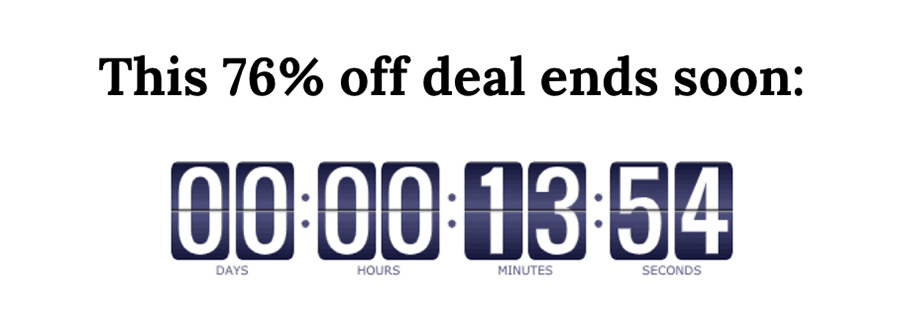
Obviously I’m not hanging out on the internet 24/7 with a stopwatch to time everyone’s 15-minute window of opportunity.
So to automate the countdown timer and keep things ethical, I use a software called Deadline Funnel to run my limited-time offers.
Deadline Funnel fires automatically, and when the timer is up readers are redirected to a thank-you page if they try to re-visit any of the pages.
The deadline is real!

Some creators make their offer disappear altogether after the deadline has passed. For my business, the special price has passed, but the offer is available at full price at any time.
You don’t have to use a timer. If you don’t, though, your LTO is not actually a limited-time offer; it’s just an offer.
I’ve pitched my offer with and without a limited-time window personally, and having a limited-time window increases conversion.
There are many ways to make money on Medium; the key is to decide which approach or approaches you want to take and then get into action!
THE CATEGORY IS: “SUMMARY OF CHAPTER 5” REALNESS
>>> The Medium Partner Program is easy to sign up for and lets your articles make money by putting them behind a paywall.
>>> You can still share paywalled articles with your audience for free using “friend links”.
>>> Bringing Medium readers off of Medium and onto an email list will set you up to sell via email down the line if you choose.
>>> You can actually sell to Medium readers before they ever even see an email from you by using a “limited-time offer”.

To supplement this guide and help you take action, I have a free toolkit you should check out. It’s called The Medium Jumpstart Toolkit, and it includes:
– “The 5-Step Checklist For Succeeding On Medium” PDF
– A free, private 5-episode mini-podcast
– A behind-the-scenes video of exactly how I run my Medium workflow using Google Docs and Google Sheets

We’ve gone through quite a lot already together!
So far we’ve covered what Medium is, what publications are, how to grow your audience, and how to make money with Medium if you so choose.
Now… what numbers should you pay attention to when writing on Medium, and what other numbers can you ignore completely?
In this final chapter on Medium stats we’ll do a quick overview of your stats dashboard.

Medium Stats: A breakdown
When you go to click on your Medium stats, it can start to feel overwhelming.
“What do all these numbers mean?”
“Are these numbers good or bad?”
“Oh God, my traffic isn’t as good as it was last week… I suck.”
Here’s my two cents: Don’t overthink it!
When you’re just getting started you don’t need to analyze your numbers too much – I’d rather you invest that energy into writing articles and putting them out there.
That being said, it’s helpful to have an idea from day one of what the different numbers actually mean.
Views
On Medium, views are when someone has clicked on an article of yours to begin reading it.
Already, a view is an achievement, because it means that in the sea of articles published on Medium someone picked your article based on its headline and its hero image.
To get views on Medium, you have to have a clear or interesting headline.
On the stats dashboard, you can see a summary of overall views for the past 30 days, and can also see previous months’ performance.
(You can’t pull a report on these, though, so if you want performance for a given month you’ll have to add any straggler days manually.)

Then, next to each article, you can see a summary of how your article has done.
When you click on an article, you’ll get day-by-day stats of both internal and external views for that article.
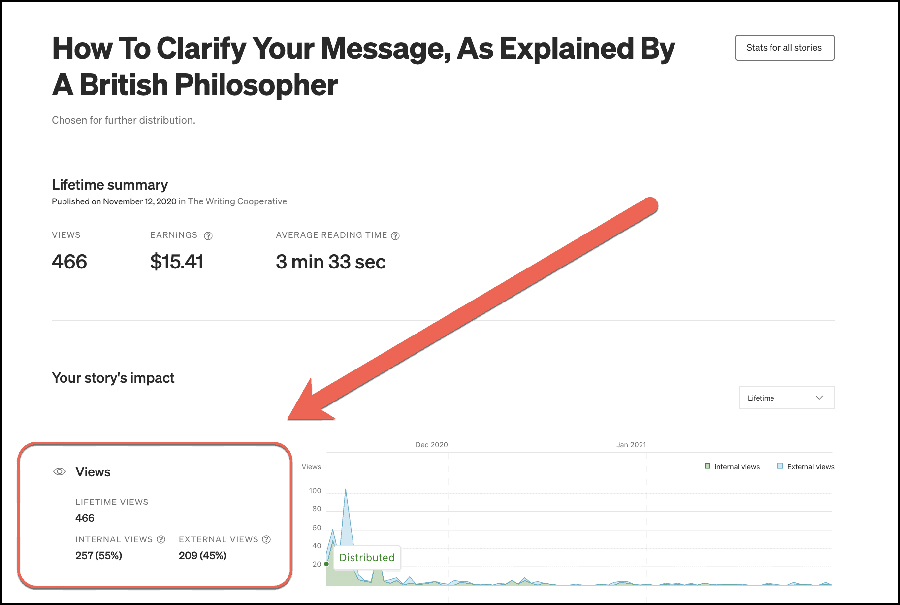
Views are like website traffic. Without views, we’re dead in the water, so they’re pretty important!
Reads and Read Ratio
Next, you have “Reads”, which Medium defines as the number of users who read the entire story.
Obviously, some readers will skim your articles and make it to the bottom, which would count as a read.
The read ratio is the percentage of views that went on to read your full article.
While holding your reader’s attention for an article is important, my experience is that the read ratio drops off the longer an article gets, so I wouldn’t “read” too much into this metric (Zing!).
If you’re putting a call-to-action to join your email list at the bottom of your articles, the “Reads” are the number of people who actually saw that.
Fans
Fans are the number of unique users that have clapped for an article of yours.
We’ll get to Claps (Which are like “Likes” for Medium) in just a moment, but know that a user can clap up to 50 times for your article on Medium.
This can make social proof look a little confusing.
For example, an article with 500 claps could have 10 fans who each clapped 50 times, or it could have 100 fans who each clapped 5 times.
Fans will tell you the number of unique users who have clapped at least once.
Additional Medium stats I measure (And also metrics I ignore)
Ignore: Claps
The problem with claps is that clap circles have cropped up all over the internet.
Users attempt to juice their articles with tons of claps, and as a result you’ll sometimes see articles with thousands or tens of thousands of claps on them, which can get demoralizing.
This social proof is sometimes fake, and these articles are actually tanking.
Here’s what to keep in mind: Clap counts don’t improve distribution very much.
What improves your distribution is getting a lot of views and having good time-on-page.
These numbers tell Medium that people are clicking to read your article, and once they arrive they stay for the quality content.
Measure: Views-To-Subscribers Ratio
If you are running an email list, a metric that might keep you motivated is calculating your views-to-subscribers ratio: How many viewers ended up becoming email subscribers?
To calculate this, I look at my Medium views for a given month, then look at how many new subscribers I gained from Medium in that given month.
For me, my new subscriber count is 1.25%-2% of my total views for the month; this helps me create some predictability around how my list is growing.
Ignore: Follower count
You’re welcome to track your followers on Medium, but I wouldn’t worry too much about it.
Medium has a nice structure: People don’t really even see your follower counts unless they either (1) read an article that you have self-published, one that is not on a publication, or (2) click on your profile to view it.
Follower counts are a vanity metric. In our approach, the audience that you truly want to prioritize is your email list.
FINAL TAKEAWAYS
So there you have it!
Hopefully after reading this guide, you now feel excited and inspired about trying out Medium as a way to reach more people, spread your message, grow your audience, and even make some moolah on the side.
Throughout this guide, you’ve been seeing me plug the Medium Jumpstart Toolkit. Here’s that fancy box one more time for ya:
AN ENCORE PRESENTATION OF “HEY, DOWNLOAD THE MEDIUM JUMPSTART TOOLKIT”
To supplement this guide and help you take action, I have a free toolkit you should check out. It’s called The Medium Jumpstart Toolkit, and it includes:
>>> “The 5-Step Checklist For Succeeding On Medium” PDF
>>> A free, private 5-episode mini-podcast
>>> A behind-the-scenes video of exactly how I run my Medium workflow using Google Docs and Google Sheets
The internet landscape can be scary and challenging at times.
What helps is to re-focus on the immense opportunities that are available to us by writing online: We can literally reach millions of people with our words!
Writing on Medium is one of the best ways to achieve this.
Thanks for reading and see you on Medium!
Nick
